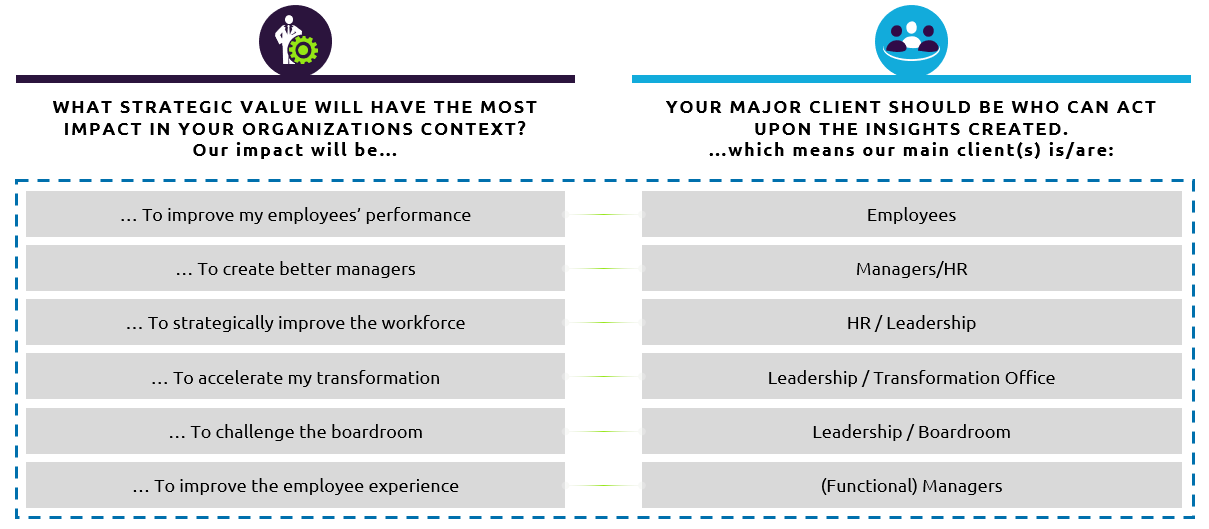A crucial step in developing your people analytics capability
“Data is the new oil” and “human capital is the number-one success factor organizations,” yet HR receives only 5% of big data investment. If you feel that these quotes don’t add up, you’re not alone. Often, HR is criticized for a lack of business acumen, and nowhere is that more telling than in the field of People Analytics: HR is sitting on a mountain of gold (data), but is somehow incapable of capitalizing on it. What gives?
Strong focus on symptoms hides the root cause
When talking People Analytics – the cross-section of data, analytics, people, and decision making – we generally speak of it as a promising, must-have capability. And rightly so, as it can serve as the stepping stone to a “data-driven HR function” that can see eye to eye with data-driven colleagues in other functions (e.g. finance, marketing, supply chain). Conversation then quickly flows to the common challenges of founding a strong People Analytics capability: not having the right data quality, not having the right IT landscape, and (occasionally) not having the right skills onboard to effectively tackle GDPR and privacy-related challenges.
These challenges require effort and skills to fix, but they are fixable. Our colleagues in other parts of the business have proven that. However, fixing them requires a strong business case in order to procure the necessary investments, and the data clearly shows that procuring these investments is not happening. Why not?
We believe it is because HR is focused on symptoms rather than the root-cause,
forgetting to articulate the strategic value of People Analytics.
It might be a side effect of wanting to provide immediate value, making us jump straight into use-case territory. Can we improve employee retention? Can we improve sales effectiveness? Can we improve workforce planning? These are useful questions to ask (and depending on your context they might be brilliant questions to ask), but there’s real value in a taking a step back and first sketching out the bigger goal: what strategic value will you deliver?
What’s your value proposition and who’s buying?
To borrow a useful framing mechanism from Marketing, consider what the value proposition of your People Analytics capability should be. What are you working towards? Are you improving employees’ performance through People Analytics? Are you creating better managers? Accelerating your organizational transformation? It helps being clear what your overarching goal is to ensure the right executive attention.
Clarity on your value proposition will also lead you to think more clearly about who should be “buying”: who can act upon the insights you will be generating? Typically, your overall stakeholder field will be a lot more sizeable and complex, but your actual “buyer” should be the person that can act upon the insights you generate. If your objective is to build better managers – managers are obviously your client base. If you’re accelerating your transformation, you’ll have a smaller group of senior leadership as clients. This will not only help you deliver your first use case, but more importantly, it will help you deliver your second, and your third, et cetera. Articulating a clear value proposition gives immediate clarity on who your most important stakeholders are.
If your value proposition aligns with your organization’s strategy, you’ve also identified the right narrative for your business case. Now you’ll be able to have a much better conversation on what use case to start with and importantly, it allows you to retain momentum by being keeping focus on the bigger picture.

Conclusion
It is useful to start lean and to go exploring, but without embedding that into a larger story of what strategic value you will deliver, you will lose out on executive attention and momentum. Because whether or not you succeed in your efforts to deliver a great use case, if you don’t have a clear articulation of 1) how that’s linked to business & HR strategy and 2) what’s next for the People Analytics capability, it is a one-time success only and you will surely miss out on “bigger and better” investments to tackle “bigger and better” challenges. HR is in possession of a lot of valuable goods, it’s time to start working on it.
By Lucas Ruijs | Strategy and Transformation, Capgemini





































